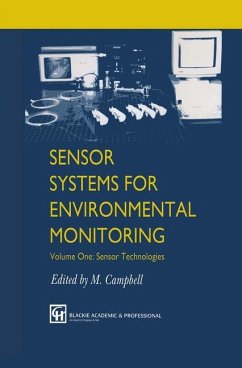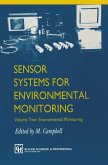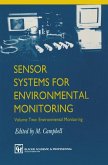1 Fibre optic sensors.- 1.1 Introduction to fibre optics.- 1.1.1 The need for environmental monitoring and new technology.- 1.1.2 Advantages and disadvantages of fibre optic sensors.- 1.2 Physical principles of fibre optic chemical sensors.- 1.2.1 Absorption sensors.- 1.2.2 Sensing through indicator dyes.- 1.2.3 Fluorescence sensors.- 1.2.4 Raman sensors.- 1.2.5 Refractive index and optical path length sensors.- 1.2.6 Evanescent field sensors.- 1.3 Sensor construction and basic types.- 1.3.1 Fibre optics with absorption cells.- 1.3.2 Fibre opt(r)odes.- 1.3.3 Evanescent field sensor types.- 1.3.4 Sol¿gel coatings.- 1.3.5 Other types of sensor construction.- 1.3.6 Source and detector considerations.- 1.4 Examples of fibre optic sensors for environmental applications.- 1.4.1 Air pollutants.- 1.4.2 Seawater monitoring.- 1.4.3 Ground and drinking water contamination.- 1.4.4 Soil contamination.- 1.5 Conclusion.- 1.5.1 Summary.- 1.5.2 Future trends.- References.- 2 Integrated optic sensors.- 2.1 Introduction to integrated optics.- 2.1.1 Waveguides.- 2.1.2 Waveguide couplers.- 2.1.3 Optical modulators and switches.- 2.1.4 Integrated optic light sources.- 2.1.5 Integrated optical detectors.- 2.2 Fabrication of integrated optic devices.- 2.2.1 Materials for integrated optic devices.- 2.2.2 Fabrication and modification of thin films.- 2.2.3 Patterning processes.- 2.3 Sensor techniques in integrated optics.- 2.3.1 Evanescent waves.- 2.3.2 Spectroscopy.- 2.3.3 Ellipsometry.- 2.3.4 Surface plasmon resonance.- 2.3.5 Light scattering.- 2.3.6 Optical biosensors.- 2.4 Applications of integrated optic devices for environmental sensing.- 2.4.1 An integrated optic biosensor.- 2.4.2 An integrated optic gas sensor.- 2.5 Conclusions.- References.- 3 Laser-based sensors.- 3.1 Introduction.- 3.2 Laser mass spectrometry.- 3.2.1 Resonance ionisation mass spectrometry.- 3.2.2 Factors determining the experimental arrangement.- 3.2.3 Ultra-trace detection of explosive molecules using REMPI.- 3.2.4 Trace detection of urban impurities.- 3.2.5 Trace detection of radiotoxic isotopes by RIMS.- 3.3 Laser remote sensing.- 3.3.1 LIDAR.- 3.3.2 DIAL.- 3.4 Applications of LIDAR.- 3.4.1 Mie scattering LIDAR.- 3.4.2 Raman LIDAR.- 3.4.3 Fluorescence LIDAR.- 3.5 DIAL.- 3.6 Laser absorption spectroscopy.- 3.6.1 Transmission methods.- 3.6.2 Direct laser absorption methods.- 3.6.3 Fixed frequency laser IR spectroscopy.- 3.6.4 Photoacoustic spectroscopy.- 3.6.5 Thermal lens spectroscopy (TLS).- References.- 4 Electrochemical sensors.- 4.1 Introduction.- 4.2 Voltammetric and potentiometrie techniques.- 4.2.1 Background.- 4.2.2 Applications.- 4.3 Microelectrode voltammetric sensors.- 4.3.1 The microelectrode sensor.- 4.3.2 Principle of operation.- 4.3.3 Fabrication techniques.- 4.3.4 Microelectrode measurement system considerations.- 4.3.5 Linear ramp cyclic voltammetric measurement systems.- 4.3.6 Anodic stripping analysis.- 4.3.7 Diagnostic techniques.- 4.4 Thick film sensors.- 4.4.1 Chemical environmental sensor arrays.- 4.4.2 Palintest disposable sensors.- 4.5 Ion-selective electrodes.- 4.5.1 Ion-sensitive field effect transistors.- 4.6 Summary.- References.- 5 Gas sensors and analysers.- 5.1 Gas sensors.- 5.1.1 Portable gas detectors.- 5.1.2 Portable continuous gas monitors.- 5.1.3 Fixed continuous gas measurement installations.- 5.2 Principles of gas detection.- 5.3 Catalytic oxidation gas sensors.- 5.3.1 Unembedded resistance filament sensors.- 5.3.2 Catalytic oxidation pellistors.- 5.4 Thermal conductivity pellistors.- 5.4.1 An inexpensive gas alarm for CO2 leakages.- 5.4.2 MSA model LV combustible gas indicator.- 5.5 Taguchi sintered semiconductor sensors.- 5.5.1 Principle of operation.- 5.5.2 Diffusion-reaction model.- 5.5.3 Thermal cycling of TGS heating filaments.- 5.6 Recent developments.- 5.6.1 Electronic noses.- 5.6.2 Metal oxide sensors.- 5.6.3 Single crystal thin film sensors.- 5.6.4 Thin film metal oxide sensors.- 5.6.5 Incorporation of catalysts.- 5.7 Zirconia devices.- 5.8 Organic conductors.- 5.8.1 Metal phthalocyanine sensors.- 5.8.2 Other materials.- 5.9 Conducting polymer sensors.- 5.10 Electrochemical cells for gas sensing.- 5.10.1 Clark cells.- 5.10.2 Metallised membrane cells.- 5.10.3 CiTiceLs for O2 measurements.- 5.10.4 Toxic gas cells.- 5.11 Gas analysers.- 5.11.1 Introduction.- 5.11.2 Principles of operation.- 5.11.3 Differential optical absorption spectroscopy.- 5.11.4 Fourier transform IR spectroscopy.- 5.11.5 Differential absorption LIDAR.- 5.11.6 Laser-induced fluorescence.- 5.11.7 Chemiluminescent techniques.- 5.11.8 Jamin type interferometer.- 5.12 Conclusions.- References.- 6 Piezoelectric sensors.- 6.1 Introduction.- 6.2 Piezoelectric crystal theory.- 6.3 Instrumentation.- 6.4 Gas analysis.- 6.5 Piezoelectric aerosol sensors.- 6.6 Piezoelectric crystal liquid sensors.- 6.7 PZ sensor coatings operating in liquids.- References.- 7 Biosensor devices.- 7.1 General introduction.- 7.2 The enzyme electrode.- 7.2.1 Enzyme kinetics.- 7.2.2 Inhibition of catalysis.- 7.2.3 Kinetic and mass transport considerations for an enzyme electrode.- 7.3 Preparation of the immobilised enzyme layer.- 7.3.1 Gel entrapment.- 7.3.2 Adsorption.- 7.3.3 Covalent immobilization.- 7.3.4 Immobilisation of enzymes to metal electrodes.- 7.3.5 Immobilisation of enzymes to carbon electrodes.- 7.3.6 Immobilisation in an electrochemically grown organic polymer.- 7.4 Theoretical considerations for amperometric enzyme electrodes.- 7.5 Enzyme electrodes for substances of environmental interest.- 7.5.1 Pesticides.- 7.5.2 Phenols.- 7.5.3 Heavy metals.- 7.5.4 Mass manufacture of enzyme electrodes.- 7.6 Whole cell sensors.- 7.6.1 Microbial biosensors.- 7.6.2 Theoretical considerations.- 7.6.3 Immobilisation of microbial whole cells.- 7.6.4 Methods of monitoring whole cells.- 7.6.5 Applications.- 7.7 Immunosensors.- 7.7.1 Kinetics of antigen¿antibody binding.- 7.7.2 Immobilisation of antibodies.- 7.8 Schemes for electrochemical/electrical immunosensors.- 7.8.1 Reagentless immunoprobes.- 7.8.2 Semiconductor systems.- 7.8.3 Piezoelectric systems.- 7.8.4 Voltammetric immunoassay schemes.- 7.9 Conclusions.- References.- 8 Automated measurement.- 8.1 Introduction.- 8.2 General principles.- 8.2.1 Sampling.- 8.2.2 Resolution.- 8.3 Analogue interfacing.- 8.3.1 Buffer amplifier.- 8.3.2 Voltage attenuator.- 8.3.3 Amplification.- 8.3.4 Current-to-voltage converters.- 8.3.5 Filters.- 8.3.6 Sample and hold circuits.- 8.4 Digital interfacing.- 8.4.1 Introduction.- 8.4.2 The general purpose interface bus: IEEE.488.2.- 8.4.3 Serial interface standards.- 8.4.4 VME/VXIbus.- 8.4.5 CAMAC.- 8.4.6 HART field communication protocol.- 8.4.7 Networks and fieldbus.- 8.5 Hardware aspects.- 8.5.1 Computers.- 8.5.2 Rack-based systems.- 8.5.3 Interface boards/modules.- 8.5.4 Data loggers.- 8.5.5 Portable data-acquisition systems.- 8.6 Software.- 8.7 Summary.- Further reading.
Bitte wählen Sie Ihr Anliegen aus.
Rechnungen
Retourenschein anfordern
Bestellstatus
Storno









